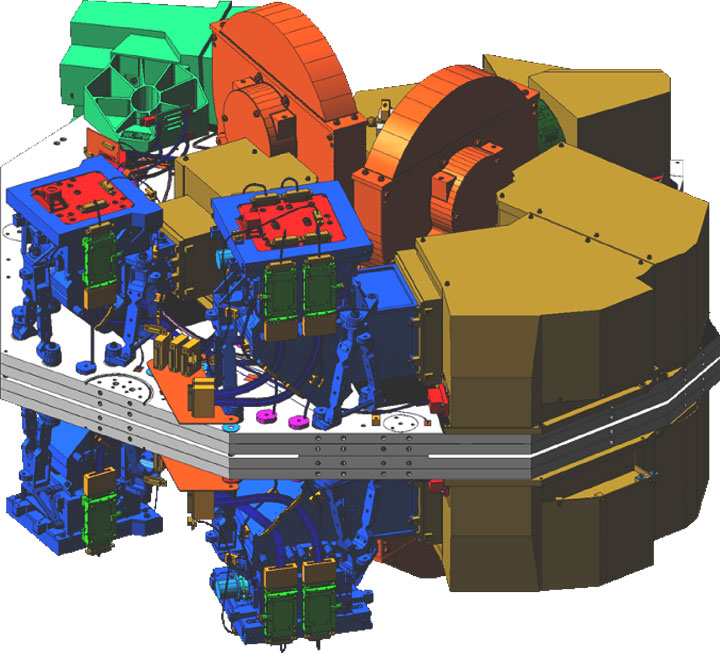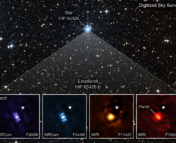Title: NGST NIRCam Scientific Program and Design Concept
Authors: Marcia J. Rieke, Stefi Alison Baum, Charles A. Beichman, David Crampton, Rene Doyon, Daniel Eisenstein, Thomas P. Greene, Klaus-Werner Hodapp, Scott D. Horner, Doug Johnstone, Lawrence Lesyna, Simon Lilly, Michael Meyer, Peter Martin, Donald W. McCarthy Jr., George H. Rieke, Thomas L. Roellig, John Stauffer, John T. Trauger, Erick T. Young
First Author’s Institution: Department of Astronomy and Steward Observatory, University of Arizona, Tucson, AZ, USA
Status: Published in Proceedings of the SPIE IR Space Telescopes and Instruments [closed access]
Have you ever wondered where NASA’s images of nearby stellar nurseries, jets erupting from young active stars, and the most distant (earliest) galaxies come from? These days, most come from JWST (once called the Next Generation Space Telescope; NGST)–an 8 meter infrared (IR) satellite that launched in late 2021–specifically from an near-infrared (NIR) instrument aboard JWST named NIRCam. NIRCam is primarily a photometric imager, meaning it uses the light collected from JWST’s mirrors, passes it through filters that limit the wavelengths of light that reach the detector, and takes a picture! This bite dives into the early engineering decisions of NIRCam and how the design was tailored, over two decades ago, to enable the science JWST produces now.
Designing an Astronomical Instrument
To design an astronomical instrument or telescope, astronomers first think about their dream science cases–observations that cannot be done with current facilities but would help us learn more about the universe if we could do them. Then, astronomers partner with engineers to intentionally design instruments and telescopes that can carry out these observations.
The design of JWST and all of its instruments was guided by 25 science cases developed between 1997 and 1999, in a document called the design reference mission (DRM). The DRM includes science cases from several different astronomical sub-fields so JWST and each instrument on JWST can be used to obtain observations that will answer a broad range of astronomical questions. NIRCam, as an instrument on JWST, was designed and built using the science cases outlined in the DRM as guides.
Additionally, instrumentalists have some say in the design of the instruments they build–a nice perk! In this case, the astronomers on the NIRCam team added 3 science cases in addition to the DRM that also influence the design of the instrument: a deep survey of far away galaxies to study early galaxy formation, a survey of dense molecular clouds and young stars to better understand how stars form, and a survey of the circumstellar disks to answer questions about how the disks form, evolve, and create planets.
The NIRCam Design Requirements
What does design requirement actually mean? This paper outlines several instances of design requirements for NIRCam–making an engineering design choice to enable specific science. For example, one of NIRCam’s science goals is to study the earliest galaxies since they are integral to understanding galaxy evolution. Astronomers want the best chance at detecting as many early galaxies as possible in a single image which drives the engineering requirement of NIRCam having a large field of view.
Since early galaxies are faint, the exposure time required to detect them is very long, making early galaxies time-intensive to detect. To make NIRCam as time-efficient as possible when observing faint objects, the NIRCam team added the ability to image in multiple filters or wavelength ranges at the same time using a dichroic filter. Filters allow a specific range of wavelengths to pass through while absorbing all of the others, but a dichroic filter reflects the rejected wavelengths instead of absorbing them. The reflected wavelengths can then be sent to another detector to produce an image of the same field in different wavelengths.

Finally, one of the most important roles of NIRCam on JWST is acting as the wavefront sensor. This means that NIRCam is used to align and focus all 18 of the JWST mirror segments. If the mirror segments are not aligned JWST will not focus correctly on the targets–think of taking a photo out of focus, the image will look blurry! Since successful mirror alignment and a focused image is integral to the scientific success of all of the instruments on JWST, the NIRCam design features two identical optical systems (shown in Figure 1). If the wavefront sensing in one of the modules fails, the other can be used as a backup!
Designing the NIRCam Filters
One of the primary science goals of JWST is finding the highest redshift (earliest) galaxies. Redshift is a way of describing how far away a galaxy is from Earth and is often measured using strong emission lines in galaxies, but this is very time-expensive for early galaxies. We can instead estimate redshift using multi-wavelength photometry, called the “dropout” technique, which is explained in this bite discussing the discovery of high-redshift galaxies using the Hubble Space Telescope.
Sets of broad- or wide-band filters that span a larger range of wavelengths make detecting fainter objects easier since they collect more light, but these filters are difficult to calibrate. To determine the number and width of filters that enable the most accurate photometric redshift estimation, the NIRCam team simulated the detection of several samples of galaxies with JWST at different redshifts. They found the best redshift accuracy and detection rate occurs with 7 filters of R=4, where R is the spectral resolution or the width of the filter relative to the central wavelength. The final design of NIRCam features 8 wide-band filters that span a similar wavelength range as the original 7 filters featured in this paper.

The selection of the intermediate-band filters in NIRCam is driven by the star formation, debris disk, and planetary system science cases with the goal of detecting features in molecular clouds, circumstellar disks, and solar system objects. Figure 3 shows the spectral features of several ices and how they appear in the spectra of a few objects in addition to the footprints of the NIRCam wide- and intermediate-band filters. The intermediate-band filters were specifically designed to overlap with CO, CO2, and N2 absorption as well as emission from Polycyclic Aromatic Hydrocarbons (PAHs). Several more intermediate-filters were added in the final design of NIRCam, providing more overlap between the initial 8 planned in this paper, bringing the total number of intermediate-filters to 12.
NIRCam at Work!
This is one of the early papers describing features of the NIRCam design (with the idea for NIRCam, at the time an Imaging Fourier Transform Spectrometer, first appearing in the literature for NGST in this paper from 2000), but there are now over 100 papers describing the NIRCam design, testing, and implementation with many more featuring NIRCam science results!
If you’re interested in what NIRCam is up to now, post-launch, check out some of these other Astrobites articles on NIRCam Image Reduction and NIRCam results coming from the CEERS survey on active galactic nuclei (AGN) and more AGN.
Astrobite edited by Olivia Cooper and Maria Vincent
Featured image credit: NASA




